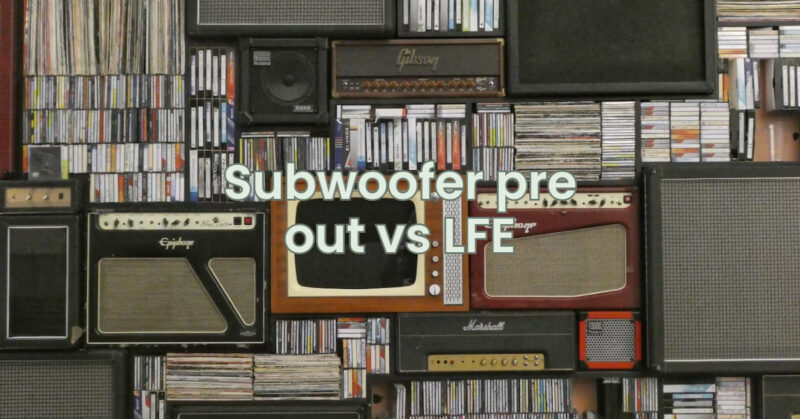Subwoofers play a crucial role in reproducing low-frequency sounds and enhancing the overall audio experience. When setting up a subwoofer, you may come across terms like “Subwoofer Pre Out” and “LFE.” In this article, we will delve into the differences between Subwoofer Pre Out and LFE, explaining their functions and how they are used in audio systems.
Subwoofer Pre Out:
The Subwoofer Pre Out is a dedicated output found on audio receivers or amplifiers that allows you to connect a powered subwoofer. It sends a full range of low-frequency signals to the subwoofer, allowing it to handle the bass frequencies independently. The Subwoofer Pre Out is usually labeled as “Sub Out” or “Subwoofer Out” on the back panel of the receiver or amplifier.
LFE (Low-Frequency Effects):
LFE, short for Low-Frequency Effects, is a specific channel used in home theater systems to reproduce low-frequency sounds, typically found in movies or other multimedia content. The LFE channel is dedicated solely to low-frequency effects, such as explosions or rumbling sounds, and is commonly referred to as the “.1” channel. It is typically sent through the LFE output, which is also labeled as “LFE Out” on audio receivers or processors.
Differences and Usage:
- Signal Type:
The Subwoofer Pre Out sends a full range of low-frequency signals to the subwoofer. It includes all the low-frequency content present in the audio signal, allowing the subwoofer to reproduce a wide range of bass frequencies. This is suitable for music playback or when using a subwoofer in a two-channel stereo setup.
On the other hand, the LFE channel is specifically designed to handle low-frequency effects in movie soundtracks. It carries a limited frequency range, focusing on deep bass and sub-bass sounds found in special effects. The LFE channel is primarily used in surround sound setups, where the audio processor or receiver directs dedicated low-frequency effects to the subwoofer.
- Crossover Settings:
When using the Subwoofer Pre Out, it is essential to set the appropriate crossover frequency. The crossover determines the point at which the main speakers and the subwoofer share the audio frequency range. This ensures a smooth transition between the speakers and the subwoofer, preventing overlap or gaps in the sound spectrum.
In the case of the LFE channel, the crossover settings are typically handled by the audio processor or receiver. The LFE channel is specifically designed to receive a filtered low-frequency signal, so the crossover settings are often predetermined by the audio content itself.
- Application:
The Subwoofer Pre Out is commonly used in various audio setups, including stereo systems, home theaters, or dedicated music setups. It allows for flexibility in adjusting the subwoofer’s volume, phase, and crossover settings to achieve optimal bass integration with the main speakers.
The LFE channel, as part of a surround sound system, is primarily used for movie soundtracks and other multimedia content that contain discrete low-frequency effects. It provides a dedicated channel for powerful and impactful bass reproduction, enhancing the immersive experience.
Conclusion:
Understanding the differences between Subwoofer Pre Out and LFE is crucial for setting up your audio system correctly. The Subwoofer Pre Out provides a full range of low-frequency signals for versatile bass reproduction, while the LFE channel is dedicated specifically to low-frequency effects in surround sound setups. Knowing how to use each connection properly ensures optimal bass performance, whether you’re enjoying music, movies, or other multimedia content. Remember to adjust the crossover settings and fine-tune the subwoofer accordingly to achieve a balanced and immersive audio experience.

